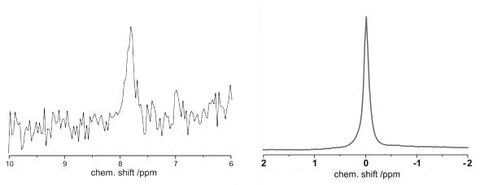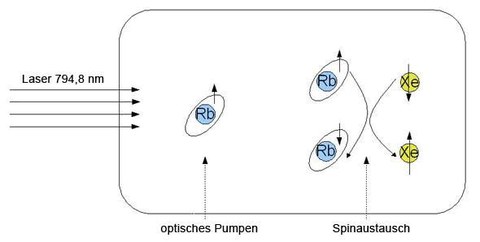Xenon and hyperpolarized Xenon in the NMR
Xenon recently finds numerous applications. For example, xenon is used as a probe molecule in materials science. It also serves for the detection of specific as well as non-specific binding places on protein surfaces in solution. Due to its hydrophobic properties, xenon is well suited in order to locate so-called hydrophobic cavities in proteins. This can be done, e.g., by the detection of xenon-induced H-1, N-15, or C-13 chemical shift changes. Furthermore, the Xe-129 NMR chemical shift tends to be much higher than that of H-1 nuclei (up to ca. 300 ppm). However, NMR exhibits a relatively low sensitivity resulting from the low spin polarization in thermal equlibrium. Hyperpolarization of noble gases may increase the polarization and, therefore, the sensitivity by 4-6 orders of magnitude.
In the case of Xe-129, for instance, the equilibrium polarisation at a magnetic field of 7 Tesla at room temperature amounts to only 0,0007%. In contrast, hyperpolarised Xe-129 attains nuclear spin polarisations of up to about 50%.

Comparison between thermically polarised xenon (left) and hyperpolarised xenon (right)
In our group, xenon projects focus on the following subjects:
- numerical simulations and experiments to augment our understanding of the hyperpolarisation process and to optimise it
- NMR-spectroscopic inquiries of proteins via noble gases (Xenon, Argon),
e.g. via chemical shift mapping - xenon-NMR spectroscopy and spin polarisation transfer onto proteins via hyperpolarised xenon
The hyperpolarisation process of Xe-129 starts by optically pumping the valence electrons of an alkali atom, e.g. rubidium, using a laser. The rubidium valence electrons in turn can transfer electron spin polarisation to the noble gas nuclei via spin exchange.

Circularly polarised laser light (wave length 794.8 nm) enters a mixture of rubidium vapour, helium, nitrogen, and xenon within an oven of controlled temperature
To improve efficiency of our apparatus extensive theoretical considerations and numerical simulations using the finite-element-method have been conducted in our group. With the aid of these numerical 3D simulations, the thermo- and aerodynamical processes within the pump cell can be modelled in a realistic manner, as comparison to our experiments shows.

oven temperature dependent distribution of xenon nuclear spin polarisation within a pump cylinder.
By varying various system parameters (oven temperature, xenon, nitrogen, and helium partial pressure, laser power etc.) we can optimise the conditions of the pumping process to achieve maximum xenon polarisation.
